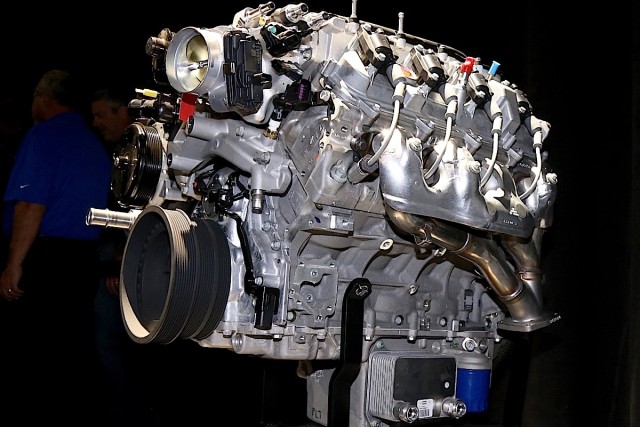 It was past and present on display as Chevrolet unveiled 1,055 horsepower in the form of new Gen I ZZ6 and Gen V LT4 crate engines as part of the automaker’s SEMA activities Monday night before the show officially opens.
It was past and present on display as Chevrolet unveiled 1,055 horsepower in the form of new Gen I ZZ6 and Gen V LT4 crate engines as part of the automaker’s SEMA activities Monday night before the show officially opens.
Chevy Performance had already announced in a SEMA teaser a few weeks ago the coming of the ZZ6, the company’s latest iteration of the popular 350-based crate engine. But the LT4 announcement was somewhat of an expected surprise and falls on the heels of last year’s release of the LT1 crate engine.
“The good news is that development was a carryover from the LT1,” says Russ O’Blemes, manager of GM Racing Powertrain Group. “The harness was very close and the production calibration is very good. We had to take the car stuff out of the calibration but the functional and WOT calibration is pretty much what you’d get in your ZO6.”
The 6.2-liter supercharged LT4 is rated at 650 horsepower with 650 lb-ft peak torque. It carries a MSRP of $15,625 and will be available in either wet- or dry-sump versions (PN 19332702 dry, 19332621 wet). A GM ECU (PN 19331517) is required for manual transmission applications, while a custom ECU would have to be obtained for use with an automatic. The dry-sump version also requires production or aftermarket oil lines and oil tank. The engine is not intended for marine use.
The LT4 is found in the 2015 Corvette Z06 and is the most powerful production engine ever offered by General Motors. It features direct injection, variable valve timing and a 1.74-liter four-lobe supercharger that provides nearly 10 pounds of boost.
Additional views of the LT4 crate engine.

1970 Chevrolet Camaro RS with supercharged LT4 crate engine and Camaro Hyper Blue concept car that was part of Chevy’s SEMA presentation on November 2.
Chevy showed off the LT4 in a trick 1970 Camaro project car that was designed along the same lines as a 2016 Camaro Hyper concept. The classic body style was upgraded with LED headlamps, rack-and-pinion steering and four-link/coil-over rear suspension.
“The LT4 represents a new threshold in technologically advanced, production-based choices for builders,” says Jim Campbell, vice president of performance vehicles and motorsports at Chevrolet. “Whether it’s in a classic Camaro, like this restomod concept, a vintage truck, or a street rod, the possibilities are almost endless.”
In other Gen V news, Chevy announced that a 376ci LT1-based engine will be one of three powerplants offered in the 2016 COPO Camaro. Again, just 69 units of the legendary nameplate will be built. Funny Car racer Courtney Force helped design some of the graphic and visual elements for car No. 1, which will be auctioned off at Barrett-Jackson next year to benefit United Way.
GM started building the COPO Camaro in 2012 with a goal of producing race-ready vehicles for Stock and Super Stock eliminator classes.
“We had the 350 and 396 in the past to cater to the Stock racers who want to run in the lower classes,” says O’Blemes. “This is to fill that void.”

The 2016 COPO Camaro will feature a 376i LT1-based engine as the 350 and 396 engines are cut from the lineup. Below is the 350ci supercharged engine. Also available is a 427ci naturally aspirated version.
 In addition to the LT1 engine, the COPO can be ordered with either a 427ci naturally aspirated engine or a supercharged 350ci engine. All will be backed by a race-prepped three-speed automatic.
In addition to the LT1 engine, the COPO can be ordered with either a 427ci naturally aspirated engine or a supercharged 350ci engine. All will be backed by a race-prepped three-speed automatic.
GM hasn’t finalized specs on the new LT1 engine.
“Obviously we’ll do our magic to get the performance where we want it,” adds O’Blemes. “It will be a proper race engine. We’re not quite sure where it will be in horsepower rating. We’re working with NHRA to make sure it’s in the right spot.”
On a side note, O’Blemes says development continues on an LT-based engine for the Corvette endurance race team. Current homologation restrictions call for continued use of the current 5.5-liter LS-based engine.
A price has not been announced for the new ZZ6 crate engine. It will be offered in Base (PN 19351532) and Turn Key (PN 19351533) versions. The Base kit includes a single-plane intake, distributor, water pump, damper, and flex plate. The Turn Key model includes a carburetor, air cleaner that matches the unique valve covers, starter, alternator, and additional accessories such as the air conditioning compressor and front-end accessory drive.
The ZZ6 is rated at 405 horsepower with 405 lb-ft peak torque (the first ZZ crate engine was introduced in 1989 and was rated at 350 horsepower). It features numerous upgrades culled from late-model engines to improve performance and reliability, such as an aggressive (.474/.510-inch lift and 208/221-degrees duration) roller cam, serpentine belt, roller-tip rockers and stepping up from dual valve springs to the beehive — which is technology from the LS3.
Views of the ZZ6 crate engine.
“We know there are still a lot of customers out there that want that Gen I engine. We’ve always tried to get the value out there. The package is pretty well developed and we did quite a bit of validation,” says O’Blemes, noting that the powertrain team did consider other upgrades. “To meet the targets we didn’t need to spend that extra money. The customer really wants that value. When we started looking at cost versus return, we just didn’t see it there.”
GM officials also hinted that an updated big-block could be in a future performance parts catalog.





























